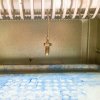JWFilips
Well-Known Member
Hi Folks,
Well as usual I jumped into this project and took it to completion without one Step by Step photo!
(Hey that has been my job for 47 years so When I do things for enjoyment the camera is not close by! )
)
Anyway I stated entertaining the thought because I found a seller on eBay that had the complete "InkBird" PID control kit at a great price!
$31.44 free shipping + tax in your state
https://www.ebay.com/itm/Inkbird-PID-Digital-Temperature-Controller-ITC-100-VH-K-sensor-Thermostat-110V/222076892641?ssPageName=STRK:MEBIDX:IT&_trksid=p2057872.m2749.l2649
Then I found this guy's website with a great wiring for the INKBird PID in an oven:
https://www.instructables.com/id/PID-Temperature-Controlled-Oven/
OK why "InkBird" Great price....Great reputation and all in al nice people to work with!
Now this was my first attempt and I did have to ask some questions form the smarter folk here!
But I got 'er done and I am ver excited wit the results. The unit I bought was in Celsius so I chose 207 Deg C for my set temperature!
That equates to 404.6 degrees F
The unit now holds my oven at 404.6 + or - .1 degree! and I do not even have to watch it....no sagged bullets no undercooked bullets Best money and project I have done in awhile.
Granted I only used the extra parts & wires I on hand and did not but anything else! ( cheep)
When I rewired my oven elements I didn't have extra high temp wire so I had to feed one set of Heating elements out the front of my oven and the other out the rear!
OK this looks messy but works! But the key point here is I separated the Heating elements which would be controlled by the PID from the Oven's fan motor which need the normal direct 110 AC current ( otherwise it would burn out iF it was in the controlled environment!)
So the oven no has two plugs one for the fan which goes into a normal 110 ac plug and the oven heating elements that go into the PIS controlled 110 Plug!
Well this is what my first attempt looks like! ( I already have learned from this I can jump off of the PID 110 AC input terminal to eliminate a number of other 110 AC input wires) I was going for a small footprint box but now I see a larger PID control box with all outputs self contained would eliminate the wire mess!
Anyway here are some after photos of the completed project ( I know my Bad!)




Well as usual I jumped into this project and took it to completion without one Step by Step photo!
(Hey that has been my job for 47 years so When I do things for enjoyment the camera is not close by!
Anyway I stated entertaining the thought because I found a seller on eBay that had the complete "InkBird" PID control kit at a great price!
$31.44 free shipping + tax in your state
https://www.ebay.com/itm/Inkbird-PID-Digital-Temperature-Controller-ITC-100-VH-K-sensor-Thermostat-110V/222076892641?ssPageName=STRK:MEBIDX:IT&_trksid=p2057872.m2749.l2649
Then I found this guy's website with a great wiring for the INKBird PID in an oven:
https://www.instructables.com/id/PID-Temperature-Controlled-Oven/
OK why "InkBird" Great price....Great reputation and all in al nice people to work with!
Now this was my first attempt and I did have to ask some questions form the smarter folk here!
But I got 'er done and I am ver excited wit the results. The unit I bought was in Celsius so I chose 207 Deg C for my set temperature!
That equates to 404.6 degrees F
The unit now holds my oven at 404.6 + or - .1 degree! and I do not even have to watch it....no sagged bullets no undercooked bullets Best money and project I have done in awhile.
Granted I only used the extra parts & wires I on hand and did not but anything else! ( cheep)
When I rewired my oven elements I didn't have extra high temp wire so I had to feed one set of Heating elements out the front of my oven and the other out the rear!
OK this looks messy but works! But the key point here is I separated the Heating elements which would be controlled by the PID from the Oven's fan motor which need the normal direct 110 AC current ( otherwise it would burn out iF it was in the controlled environment!)
So the oven no has two plugs one for the fan which goes into a normal 110 ac plug and the oven heating elements that go into the PIS controlled 110 Plug!
Well this is what my first attempt looks like! ( I already have learned from this I can jump off of the PID 110 AC input terminal to eliminate a number of other 110 AC input wires) I was going for a small footprint box but now I see a larger PID control box with all outputs self contained would eliminate the wire mess!
Anyway here are some after photos of the completed project ( I know my Bad!)





